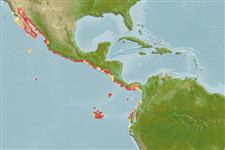Elasmobranchii (hajar och rockor) (sharks and rays) >
Myliobatiformes (Stingrays) >
Rhinopteridae (Cownose rays)
Etymology: Rhinoptera: Greek, rhinos = nose + Greek,pteron = fin, wing (Ref. 45335).
Eponymy: Franz Steindachner (1834–1919) was an Austrian zoologist who specialised in herpetology and ichthyology. [...] (Ref. 128868), visit book page.
More on authors: Evermann & Jenkins.
Environment: milieu / climate zone / depth range / distribution range
Ekologi
marina revassocierade; havsvandrande (Ref. 51243); djupintervall 0 - 65 m (Ref. 117244), usually 0 - 25 m. Tropical; 32°N - 5°S, 117°W - 76°W
Eastern Pacific: Gulf of California to Costa Rica and the Galapagos Islands. Probably occurring elsewhere.
Length at first maturity / Size / Vikt / Age
Maturity: Lm 71.0, range 65 - ? cm
Max length : 91.6 cm WD hane/ej könsbestämd; (Ref. 116975)
Adults are found over soft bottoms, near rocky or coral reefs; also near reef drop-offs (Ref. 12951). They occasionally swim near the surface and may jump out of the water. Often in schools, sometimes associated with Aetobatus narinari, the spotted eagle ray (Ref. 12951). Adults feed on benthic crustaceans and mollusks. Ovoviviparous (Ref. 50449).
Exhibit ovoviparity (aplacental viviparity), with embryos feeding initially on yolk, then receiving additional nourishment from the mother by indirect absorption of uterine fluid enriched with mucus, fat or protein through specialised structures (Ref. 50449).
McEachran, J.D. and G. Notarbartolo di Sciara, 1995. Rhinopteridae. Gavilanes. p. 782-783. In W. Fischer, F. Krupp, W. Schneider, C. Sommer, K.E. Carpenter and V. Niem (eds.) Guia FAO para Identification de Especies para los Fines de la Pesca. Pacifico Centro-Oriental. 3 Vols. FAO, Rome. (Ref. 9263)
IUCN Red List Status (Ref. 130435: Version 2024-2)
Threat to humans
Harmless
Human uses
Fiskeri: saknar intresse; Akvarium: Offentliga akvarier
Verktyg
Special reports
Download XML
Internet-källor
Estimates based on models
Preferred temperature (Ref.
123201): 19.7 - 29.1, mean 24.2 °C (based on 266 cells).
Phylogenetic diversity index (Ref.
82804): PD
50 = 0.5039 [Uniqueness, from 0.5 = low to 2.0 = high].
Bayesian length-weight: a=0.01148 (0.00463 - 0.02844), b=2.98 (2.76 - 3.20), in cm total length, based on LWR estimates for this (Sub)family-body shape (Ref.
93245).
Trofisk nivå (Ref.
69278): 3.6 ±0.50 se; based on food items.
Generation time: 4.4 ( na - na) years. Estimated as median ln(3)/K based on 1
growth studies.
Resiliens (Ref.
120179): Mycket låg, lägsta populationsfördubblingstid mer än 14 år (k = 0.25; tmax = 10.75; tm = 3.92; Fec = 1).
Fishing Vulnerability (Ref.
59153): Moderate to high vulnerability (50 of 100).
Nutrients (Ref.
124155): Calcium = 7.27 [0.83, 109.36] mg/100g; Iron = 0.396 [0.033, 4.161] mg/100g; Protein = 20.6 [15.3, 25.9] %; Omega3 = 0.0736 [, ] g/100g; Selenium = 29 [6, 147] μg/100g; VitaminA = 30.9 [2.6, 334.1] μg/100g; Zinc = 0.769 [0.049, 8.696] mg/100g (wet weight);
